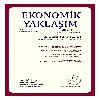Dünya enerji tüketimi:1980-2005 döneminde enerji tüketimindeki değişim
The world energy consumption: Changing in energy consumption in 1980-2005 period
___
- ALCANTARA,V., DUARTE, R. (2004), "Comparison Energy Intensities in European Union Countries. Results of a Structural Decomposition Analysis", Energy Policy, C. 32,177-189.
- AQEEL, A., BUTT, S. (2001), "The Relationship between Energy Consumption and Economic Growth in Pakistan", Asia-Pacific Development Journal, C. 8, S.2, 100-110.
- BERNARD, Jean-Thomas, COTE, B. (2005), "The Measurement of the Energy Intensity of Manufacturing Industries: A Principal Component Analysis." Energy Policy, C. 33,221-233.
- EIA, International Energy Annua12005.
- FREEMAN, S. L., NIEFER, M. J., ROOP, J. M. (1997), "Measuring Industrial Energy Intensity: Practical Issue and Problems", Energy Policy, C. 25, 703-714.
- GALLI, Rossana (1998), "The Relationship Between Energy Intensity and Income Levels: Forecasting Long Term Energy Demand in Asian Emerging Countries", The EnergyJournal, C. 19, S. 4,85-105.
- GELLER, H., HARRINGTON, P., ROSENFELD, A. H., TANISHIMA, S., UNANDER, F. (2006), "Policies for Increasing Energy Efficiency: Thirty Years of Experience in OECD Countries", Energy Policy, C. 34, 556-573.
- GILLAND, B. (1995), "World Population, Economic Growth, and Energy Demand, 1990-2100: A Review of Projections", Population and Development Review, C. 21, S. 3, 507-539.
- GRANGER, C. W. J. (1969). "Investigating Causal Relation by Econometric and Cross-Sectional Method", Econometrica, C. 37,424-438.
- GUTTORMSEN, Atle G. (2004), "Causality Between Energy Consumption and Economic Growth", Discussion Paper D-24/2004. Agricultural University ofNorway.
- HANNESSON, Rögnvaldur (2002), Energy Use and GDP Growth, September, OPEC Review.
- LEACH, G., JARASS, L., OBERMAIR, G. M., HOFFMANN, L. (1986), Energy and Growth: A Comparison ol13 lndustrial and Developing Countries, Butterworth, Stoneham.
- LEE, C.-C. (2006), "The Causality Relationship Between Energy Consumption and GDP in G-l1 Countries Revisited", Energy Policy, C. 34, 1086-1093.
- MARTIN, Jesus Ramos, CERDA, M. Ortega (2003), "Non-Linear Relationship Between Energy Intensity and Economic Growth", ESEE Conference Frontiers 2, held in Tenerife, Spain, 12-15 Feb 2003.
- SCHAFER, Andreas (2005), "Stmctural Change in Energy Use", Energy Policy, C. 33,429- 437.
- SOYTAS, U., SARI, R. (2003), "Energy Consumption and GDP: Causality Relationship in G-7 Countries and Emerging Markets", Energy Economics, C. 25, S. 1,33-37.
- SUN, J. W. (2003), "Three Types of Decline in Energy Intensity - an Explanation for the Decline of Energy Intensity in some Developing Countries",EnergyPolicy, C. 31, 519-526.
- SUN, J. W. (2002), "The Decrease in the Difference of Energy Intensity Between OECD Countries from 1971 to 1998", Energy Policy, C. 30, 631-635.
- TIWARI, P. (2000), "An Analysis Sectoral Energy Intensity in India", Energy Policy, C. 28, 771-778.
- VAN, Phu Nguyen (2008), "Energy Consumption and Economic Development: a Semiparametric Panel Analysis", THEMA-CNRS, Universite de Cergy-Pontoise.
- THE WORLD BANK (2003), World Development Indicators, Washington, D.C.
- WORLD ENERGY COUNCIL (1993), Energy for Tomorrow's World-The Realities, the Real Options and the Agendafor Achievement, New York: St. Martin's Press.
- YOO, S.-H., (2006), "The Causal Relation Between Electricity Consumption and Economic Growth in the ASEAN Countries", Energy Policy, C. 34, 3573-3582.
- ISSN: 1300-1868
- Yayın Aralığı: 3
- Yayıncı: Ekonomik Yaklaşım Derneği
Kamu borçlanması kamu yatırımlarını dışlıyor mu?
Oktay Orçun BEKEN, Mehmet DURKAYA, Servet CEYLAN
Alfred Marshall, John Maynard Keynes ve 'iktisat ile etik' ilişkisi
Modern ile postmodern paradigmanın cumhuriyet nosyonu üzerine etkileri
An indicator of monetary conditions for Turkey
Ormanda mülkiyet hakları mücadelesi ve Orman Kanunu'nun 2/B düzenlemesi
Dünya enerji tüketimi:1980-2005 döneminde enerji tüketimindeki değişim
